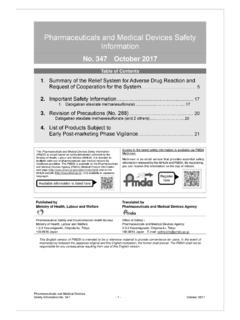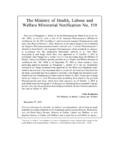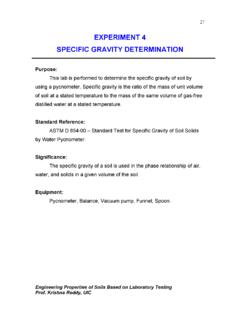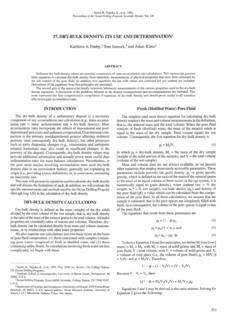Transcription of 第十七改正日本薬局方における国際調和 - Pmda
1 1 1 2 (The European Pharmacopoeia) 3 (The United States Pharmacopeia) 4 5 6 7 8 9 10 11 12 ( ) Rev. Corr. 13 14 15 16 2005 8 (Rev. 2) Residue on Ignition Sulphated Ash Test (Introduction) ( ) Procedure 1. 17 2014 6 Thermal Analysis (Introduction) ( ) Thermogravimetry 1. Instrument Temperature calibration Calibration of the electrobalance Method Differential scanning calorimetry 2.
2 Instrument Calibration of the instrument Temperature calibration Heat-quantity calibration Operating procedure Applications Phase changes Changes in chemical composition Application to phase diagrams Determination of purity Figure 1 Thermogram 1 Figure 2 Thermal diagrams according to purity 2 Table 1 1 18 19 2 2007 10 Characterisation of Crystalline and Partially Crystalline Solids by X-ray Powder Diffraction (XRPD) X (Introduction) ( ) Principle 1. Instrument 2. Instrument set-up X-ray radiation X Radiation protection Specimen preparation and mounting 3. Specimen preparation Specimen mounting Effect of specimen displacement Effect of specimen thickness and transparency Control of the instrument performance 4.
3 Qualitative phase analysis (Identification of phases) 5. ( ) Quantitative phase analysis 6. Polymorphic samples Methods using a standard Estimate of the amorphous and crystalline fractions 7. Single crystal structure 8. Figure 1 Diffraction of X-rays by a crystal according to Bragg s law 1 X Figure 2 X-ray powder diffraction patterns collected for 5 different solid phases of a substance (the intensities are normalized) 2 X ( ) Figure 3 Geometric arrangement of the Bragg-Brentano parafocusing geometry 3 20 21 22 2013 11 (Rev. 3) Bulk Density and Tapped Density of Powders ( ) Bulk density 1. Method 1 Measurement in a graduated cylinder 1 ( ) Procedure Method 2 Measurement in a volumeter 2 ( ) Apparatus Procedure Method 3 Measurement in a vessel 3 ( ) Apparatus Procedure Tapped density 2.
4 Method 1 1 Apparatus Procedure Method 2 2 Procedure Method 3 3 Procedure Measures of powder compressibility 3. Figure 1 Volumeter 1 Figure 2 Measuring vessel (left) and cap (right) 2 ( ) ( ) Figure 3 3 3 23 2003 11 Specific Surface Area (Introduction) ( ) 1. Multi-point measurement Single-point measurement Sample preparation 2. Outgassing Adsorbate Quantity of sample 3. Method 1 The dynamic flow method 1 Method 2 The volumetric method 2 Reference materials 4. Figure 1 Schematic diagram of the dynamic flow method apparatus 1 Figure 2 Schematic diagram of the volumetric method apparatus 2 24 2007 5 Gas Pycnometric Density of Solids (Introduction) ( ) Apparatus 1.
5 2. Method Expression of the results 3. Figure 1 Schematic diagram of a gas pycnometer 1 ( ) 25 26 4 27 2004 6 ( 1 ) 2007 5 (Rev. 1)( 2 ) ( ) Optical microscopy 1. 1 Apparatus Adjustment Illumination Visual characterization Photographic characterization Preparation of the mount Crystallinity characterization Limit Test of particle size by microscopy Particle size characterization Particle shape characterization General observations Figure 1 Commonly used measurements of particle size 1 Figure 2 Commonly used descriptions of particle shape 2 Analytical sieving 2. 2 Principles of analytical sieving Test sieves Test specimen Agitation methods Endpoint determination Sieving methods 1) Mechanical agitation dry sieving method ( ) 2) Air entrainment methods air jet and sonic sifter sieving ( ) Interpretation Figure 1 Commonly used measurements of particle size 1 Figure 2 Commonly used descriptions of particle shape 2 Table 1 Size of standard sieve series in range of interest 1 28 2009 10 29 Water-Solids Interactions - ( ) Introduction Physical states of sorbed water Rates of water uptake Determination of sorption-Desorption Isotherms 1.
6 Principle Methods Report and interpretation of the data Determination of the water activity 2. Principle Methods Figure 1 Example of an apparatus for the determination of the water sorption (other designs are possible) 1 Table 1 Standard saturated salt solutions 1 25 C 30 31 5 2011 6 (Rev. 2) 32 Bacterial Endotoxins Test (Introduction) ( ) Apparatus 1. 2. Preparation of standard endotoxin stock solution Preparation of standard endotoxin solution Preparation of sample solutions Determination of maximum valid dilution 3. Gel-clot technique 4. (1) Preparatory testing (i) Test for confirmation of labeled lysate sensitivity (ii) Test for interfering factors (2) Limit test (i) Procedure (ii) Interpretation (3) Quantitative test (i) Procedure (ii) Calculation and interpretation Photometric quantitative techniques 5.
7 (1) Turbidimetric techniques (2) Chromogenic technique (3) Preparatory testing (i) Assurance of criteria for the standard curve (ii) Test for interfering factors (4) Test (i) Procedure (ii) Calculation (iii) Interpretation Reagents test solutions Amoebocyte lysate Lysate TS Water for bacterial endotoxins test (BET) Table 1 1 Table 2 2 Table 3 3 Table 4 4 6 2009 6 (Rev. 1-Corr. 1)(I ) 2008 6 (Rev. 1) (II ) Microbiological Examination of Non-sterile Products : Microbial Enumeration Tests I 1 Introduction ( ) 2 General procedures 1. 3 Enumeration methods 2. 4 Growth promotion test, suitability of the counting method and negative controls 4-1 General considerations 3. 4-2 Preparation of test strains 4-3 Negative control 4-4 Growth promotion of the media 4-5 Suitability of the counting method in the presence of product 4-6 Results and interpretation 5 Testing of products 4.
8 5-1 Amount used for the test 5-2 Examination of the product 5-3 Interpretation of the results Table 1 Preparation and use of test micro-organisms I 1 Table 2 Common neutralising agents for interfering substances I 2 Table 3 Most-probable-number values of micro-organisms I 3 Microbiological Examination of Non-sterile Products:Test for Specified Micro-organisms II. 1 Introduction ( ) 2 General procedures 1. 3 Growth promoting and inhibitory properties of the media, suitability of the test and negative controls 2. 3-1 Preparation of test strains 3-2 Negative control 3-3 Growth promotion and inhibitory properties of the media 3-4 Suitability of the test method 4 Testing of products 3. 4-1 Bile-tolerant gram-negative bacteria 4-2 Escherichia coli 4-3 Salmonella 4-4 Pseudomonas aeruginosa 4-5 Staphylococcus aureus 4-6 Clostridia 4-7 Candida albicans 5 Recommended solutions and culture media 4.
9 TableII- 1 Growth promoting, inhibitory and indicative properties of media II 1 TableII- 2 Interpretation of results II 2 33 7 2009 6 (Rev. 1-Corr. 3) Sterility (Introduction) ( ) Precautions against microbial contamination 1. Culture media and incubation temperatures Media for the test may be prepared as described below, or equivalent commercial media may be used provided that they comply with the growth promotion test 2. Fluid thioglycollate medium (i) Soya-bean casein digest medium (ii) The media used comply with the following tests, carried out before or in parallel with the test on the product to be examined 3. Sterility Growth promotion test of aerobes anaerobes and fungi Method suitability test 4. Membrane filtration (i) Direct inoculation (ii) Test for sterility of the product to be examined The test may be carried out using the technique of membrane filtration or by direct inoculation of the culture media with the product to be examined 5.
10 Membrane filtration Aqueous solutions (i) Soluble solids (ii) Oils and oily solutions (iii) Ointments and creams (iv) Direct inoculation of the culture medium Oily liquids (i) Ointments and creams (ii) Catgut and other surgical sutures for veterinary use Observation and interpretation of results 6. Application of the test to parenteral preparations, ophthalmic and other non-injectable preparations required to comply with the test for sterility 7. Minimum number of items to be tested 8. Table 1 Strains of the test micro-organisms suitable for use in the growth promotion test and the method suitability test 1 Table 2 Minimum quantity to be used for each medium 2 Table 3 Minimum number of items to be tested 3 100mL 34 8 2010 11 (Rev.)














